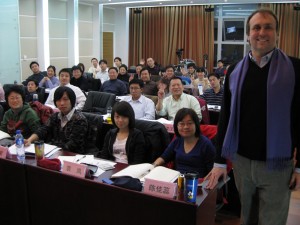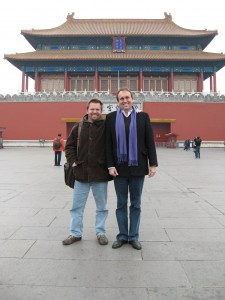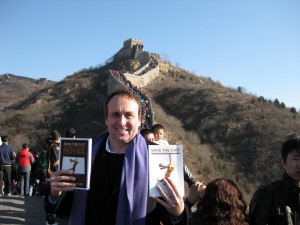
Just, just got back from China and, in a word: amazing! At the risk of blurting it all out and telling you everything I experienced — because there is so much to report — let me simply say it was one of the most informative and inspiring trips I’ve taken.
Frankly, I had some trepidation about going; it’s a long way and was scheduled during Thanksgiving. But in my never-ending quest to bring the storytelling principles of Save the Cat! to the world, and represent the readers of this blog when I do, it was my honor and privilege. And I was so graciously welcomed and treated while there, that any hesitation was quickly replaced with gratitude and delight.
Call me Chairman Meow. And call this a chance to think for a moment about markets beyond the ones we may be considering. If my experience in the past week is any indication, many more will head East in the future. For despite the fits and starts reported by those who have assayed this new world, the opportunities for the best and the brightest among us are too tempting not to consider.

Kevin Geiger is one such trailblazer. Kevin is a Disney alum, whose credits include Chicken Little and Fantasia/2000, now living and working in China full time. As President & CEO of Animation Options LLC (www.animationoptions.com) and a Sino-American enthusiast, it was his suggestion to invite me to speak to the filmmakers chosen from all over China at the Beijing Film Academy, meeting for a special month-long conference.
Joining Kevin in inviting me was Feng Wen, an author, filmmaker, and teacher, and the co-creator and co-director on the Chinese-American animated feature, The Road to Home, that Kevin is producing. Kevin writes about this project in Animation Magazine this month.
By accepting their kind invitation, I got the chance to give an hour-long talk titled “All Stories Are about Transformation” and teach a day-long class to China’s top filmmakers. I also got to meet with officials in the Chinese government who welcomed me as an honored guest.
Wherever we go in the world, the challenge is the same: It starts with “the poster” and “the idea,” and that is why Save the Cat! and my method of thinking about movies from the logline first was such a hit with my audience at the BFA. In addition to hearing about the 15 beats of my beat sheet, and my new secret weapon — the five points of the “Storming the Castle” finale — many were blown away by the fluidity of this model.

It also helps explain why one of the most popular movies in China this year is Kung Fu Panda. Between sessions, it was often cited as a film Chinese filmmakers should have made and a great example of one that marries Chinese themes and Western storytelling. As part of my talk, I dissected the 15 beats of the DreamWorks hit — and it hits them all. But I always kept coming back to the poster, the idea, the “What is it?” of every movie. If we are to compete in the global marketplace, we must always keep that in mind.
I started my class by sharing the experience I had on my first day in Beijing. I arrived, checked in to my hotel, then went for a walk. It wasn’t long before I found a movie theater. And there I was with my 100 RMB (the average price of a movie ticket) but what movie would I exchange my money for? I recognized James Bond, and the Brendan Frasier summer movie Journey to the Center of the Earth, but I was less informed about the Chinese film posters; what I would get for the price of my ticket?
And that’s the challenge.
China is rich with storytelling tradition, and now has the financial wherewithal, talent, and growing facility to compete with any film production on earth, but if you can’t attract an eager ticket buyer like me with a story that appeals on a primal level, with a poster that “resonates” and draws me in, how will I experience it?
It is the perfect example of the challenge we all face! Our ideas mean something to us, but unless we take the responsibility to attract the uninitiated with a concept that intrigues, my 100 RMB will be spent elsewhere.
For creators versed in Save the Cat! this is an opportunity to apply what we know to the biggest global market in history. If your target is such, if you want to create and produce successful franchises like Kung Fu Panda, it begins with thinking of an eager ticket buyer like me. The skills we bring to all filmmakers worldwide include creating clear, concise, primal, poster-driven stories, and demand for this skill is growing.

In addition to teaching class, I was honored to be introduced to a number of officials in the government as part of my trip. I loved meeting Mr. and Mrs. Zong, who made me feel so welcome, and Lijun Sun, the Dean of the Animation School at the Beijing Film Academy, who is a big proponent of blending Chinese and Western styles. I also had the honor of meeting Mr. Jing, Vice-minister of SARFT (the State Administration Radio, Film and Television), who is responsible for deciding which American films come to China. Last year, he chose only 20, Kung Fu Panda being one. And of the biggest Western hits in China ever, Titanic, ranks highest. Why? Why else? Poster. Primal. Boy and girl from different classes fall in love on a sinking ship. Got it. Here is my 100 RMB. I’m in!
And of course, because I am me, part of my trip to China also involved haunting the hotel Internet center to check on the progress of Four Christmases, which premiered during Thanksgiving back home. From the long list of spec sales that I perused in 2003 when I was first writing Save the Cat! I selected a few to discuss, and why they sold strictly on a concept level. Four Christmases was one of these. I dissected why that movie appealed to Hollywood, what cast it would draw, what the story was, all intuited from one simple logline. It came to fruition this holiday, opening #1 despite critical disapproval. Why? Poster. Concept. That’s what drew not only the studio that bought the script, but its cast and ultimately its audience. All based on a great, clear, primal idea! Congratulations to Four Christmas’ original screenwriters Matt Allen & Caleb Wilson and co-writers Jon Lucas & Scott Moore on their success.
When I wasn’t loitering at Box Office Mojo, or giving talks, I also got to see the sights. And I am delighted to show you the shot I imagined when I was first invited: me at the Great Wall with copies of my book. As a postscript, on my last day in Beijing, I met with Xu Weiguang, Deputy Director of China Film Press, the #1 publisher of film books in China, who excitedly grabbed my book and enthused about the title and cover photo! Thanks to our meeting, mine will be one of three books on screenwriting published in China: Story by Robert McKee, Screenplay by Syd Field, and now Save the Cat!
It’s a great cover! I was told. It makes you want to know “what is it?” But I am not surprised. Hollywood taught me about “poster” — and taught me well!
Thank you again to all those who made my stay in China such a delight, including co-speaker Steven Brown from Cal Arts, and all the students at BFA. It was a fantastic experience from beginning to end, and one I hope more Western filmmakers will experience in the future.

Blake Snyder
24 Comments
Leave a Reply Cancel reply
You must be logged in to post a comment.









Welcome back, and congratulations on your warm reception and exciting itinerary. You really got the VIP treatment!
You must be worn out by now, almost in a Cat-atonic state, so go take a well-deserved Cat-nap.
See you Saturday. :)
Blake!!
I am too tired to read your post but great that you enjoyed yourself!!!
Glad you’re back and luckily where you were evaded problems like Thailand and India!
See ya soon!
Sounds like you had a wonderful and inspiring trip! I’m betting you got the Chinese students as charged up as you have any of the rest of us.
Glad you crossed all the distances safely too!
“Save the Cat! conquers the world!”
;)
I hear that their hospitality cannot be beat and I’m glad they didn’t disappoint. Hopefully two of the books chosen for China next year will be the Cat! sequals.
Not to spark a fire or anything —
I give you a lot of credit for pointing out Four Christmases years in advance in your book. That shows a lot of insight into this business in terms of what does and doesn’t sell at the screenplay level.
I’m curious, though, how much you think critical acclaim matters versus box office receipts. Obviously, from a business standpoint, critical acclaim is irrelevant as long as the movie makes a profit. Without the ability to generate revenue you don’t have a business.
You called that Four Christmases would make money. But there really was no insight one way or the other about the quality of the story. Four Christmases has a 23% at Rotten Tomatoes. More disposable media that will quickly be forgotten.
I have read your criticisms about movies like SPIDERMAN 3, a film which did phenomenal box office, and was a rather large critical disappointment. It seems that you do draw a line somewhere between commerce and art. I am curious where: where do you see that line being?
Would you sacrifice story for a better poster? Maybe go a cliched route for a better log-line?
Again, I don’t mean these comments to come off as incendiary. I had a teacher once ask us, in the form of a survey, if we would rather write for art or for commerce. It was a Yes or No question sort of question. In the entire class of 50 some students, I was the only one that crossed out the question. Next to it I wrote, you can have both. That is where this comment is coming from.
Ironically, you were a speaker in this class and I enjoyed your insight and perspective.
Concatulations on all your success. It sounds as if your trip was purrrrfect. But one burning question remains; what movie did you spend your 100 RMB to see and did it have subtitles?
Welcome back Blake, hope they had plenty of pellegrino for you. Seems like it won’t be long before there is only one (well 2-3, same name sake though) books on screenwriting in China, and we all know what that will be. Kudos Blake!
Chairman Meow — awesome.
Great response. Thank you.
And — “But when you see how studios often veer from the script they start with, I’m surprised many movies are even in English!”
No kidding! I’ve seen this happen. I often wonder why studios even buy the specs they do when it is common practice to simply hire another writer to completely rewrite the script into something else entirely.
Wouldn’t it make more sense just to hire the “rewrite” writer in the first place and have him write what you wanted? I mean, that’s what they are doing any way.
Oh well. The bloat comes with the business I suppose. And as a screenwriter, I’m not complaining. That’s an extra writer getting paid in the current system.
BLAKE!
Welcome back! What a great story – I can’t wait to hear more. See you Saturday!
Joe Whyte
I saw “Four Christmases” and enjoyed it. It was a pleasant distraction with some notable “Fun and Games” scenes that worked. I try not to pay too much attention to the critics. If you read the reviews before going to most movies, there’s not too much you would see. Besides, critics just don’t seem to like “holiday films” or light-hearted family fare, for the most part. I do recommend “Slumdog Millionaire.” It hits its points on the BS2 very well despite its non-linear structure.
Wait! I may have missed it, but what movie did you see?
Blake, you’re now officially a part of China’s bright future-history.
Safe to say too, the Great Wall will never be the same.
That’s so great, Blake! I love the type of stories that come from the East and always have — all the East needs is a little “Save The Cat” to really compete with the West. There is such a passion that I feel when I watch movies like “Enter The Dragon” or “Crouching Tiger,” and there must be more, I can sense it. I wish it was easier to break into that market, as if Hollywood was any better! Maybe you could give a few tips? ;) Good to have you home!
Mmm, those residuals sound juicy. Hey Blake, could you dedicate a blog one day explaining the basics of residuals for us, the uninitiated? What do we have to look forward to if we end up writing a big hit like “Four Christmases”?
Hi,blake.
So happy to read your blog about your chinese journey.I am one of your student from that national screenwriter class.~~I am just beside you on the pic you post here.
Every classmates here enjoyed your “save the cat”,we have gradulated from BFA now,but we will try to use your 15 beats in our future writing.
Thank you for your wonderful course~~
Hi,blake:
I am so happy to read your EMAIL!
You are great people!
“SAVE THE CAT”!
It is so amazing!
Thanks again!
mahua (from china)
Hi Blake,
Your predictions about Four Christmases were amazing! Considering that I’m a new Snyderite, having purchased Save the Cat only last month, I was astounded that the very movie I was reading about in your book was being advertised almost 5 years later. Upon finishing your first book, I immediately purchased the 2nd, and it’s great!
Now, after I watch a DVD, I scan all the key moments and times on your beat sheet and see that all the best films I enjoy ALL follow the rules. It’s a whole new world I never knew existed. Wow!
Your books have given me the secret keys to the back door of Hollywood. I hope no one finds out that I cheated when I start selling my scripts.
:)
Wade Buffington
Pensacola, FL
Happy to have you here, Blake! Look forward to seeing you again. :-)
KG
Blake, I’m so glad you got to China! What an amazing experience that must have been! When Henry Kissinger went during the Nixon administration, my Air Force dad actually flew over BEFORE him with presents from the US government (like a Cadillac) to help open those doors.
Like your other fans, I’ve also been telling everyone about how you talked about Four Christmases long before it came out in theaters.
And my kids know all the Blake beats. I’ll say, “See? Here’s the promise of the premise, the fun and games section!” And they’re starting to call out the beats, too!
I’m using those beats so much in my books. I just wrote a 100,000-word ms. in one month, in large part thanks to your beats. Upon revision, I realized I’d somehow skipped one–the theme. I didn’t have a character asking that question to be debated throughout the book…and when I put the theme back on page one, spoken in dialogue, it made all the difference!
If this book sells, it will be in large part thanks to you, Blake! I’ll let you know, of course, if it ever does.
You take care and I hope you’ll enjoy your holidays.
Big hug from Kieran in Charleston
Actually, in my latest ms, my character didn’t ASK a question regarding the theme. He STATED something that was a debatable issue. I worked it in so it would flow!
Kieran
Saving the world from one bad story at a Time.
Sounded like lots of fun.
Hi Blake! Thank you for saying I contributed in some way to the enjoyment of your trip! Hope to hang out with you again sometime!
Did Blake ever release a BS2 beat sheet breakdown of Kung Fu Panda? Would love to read it.